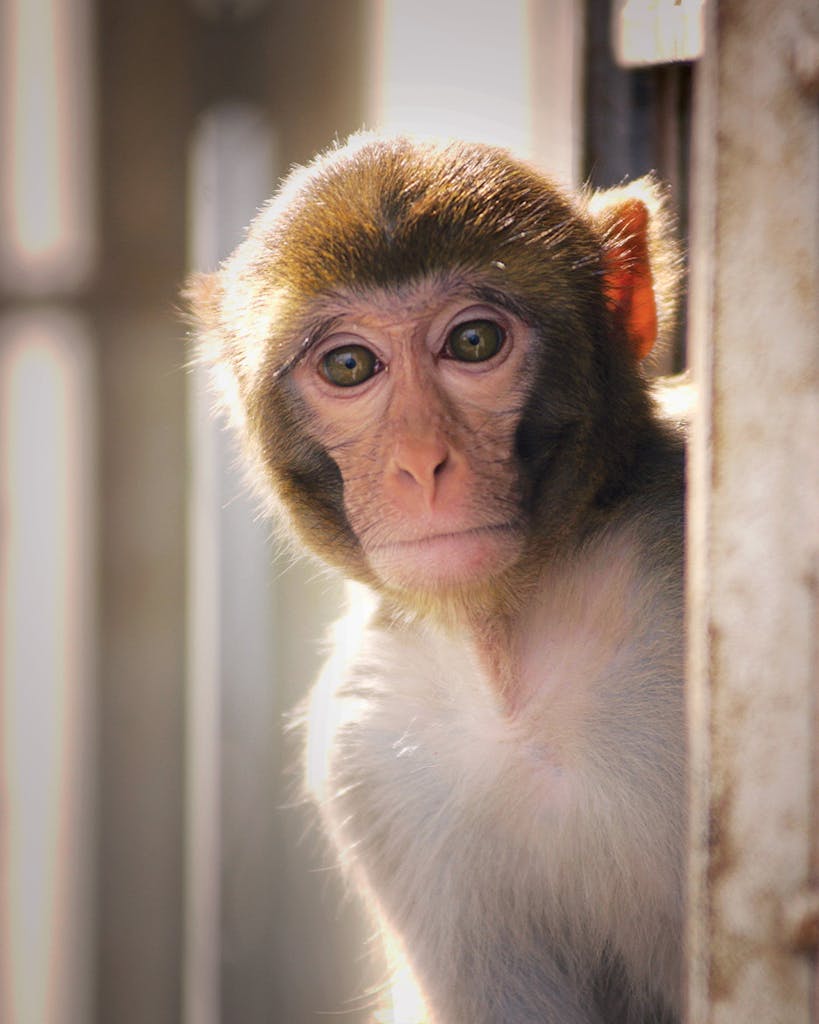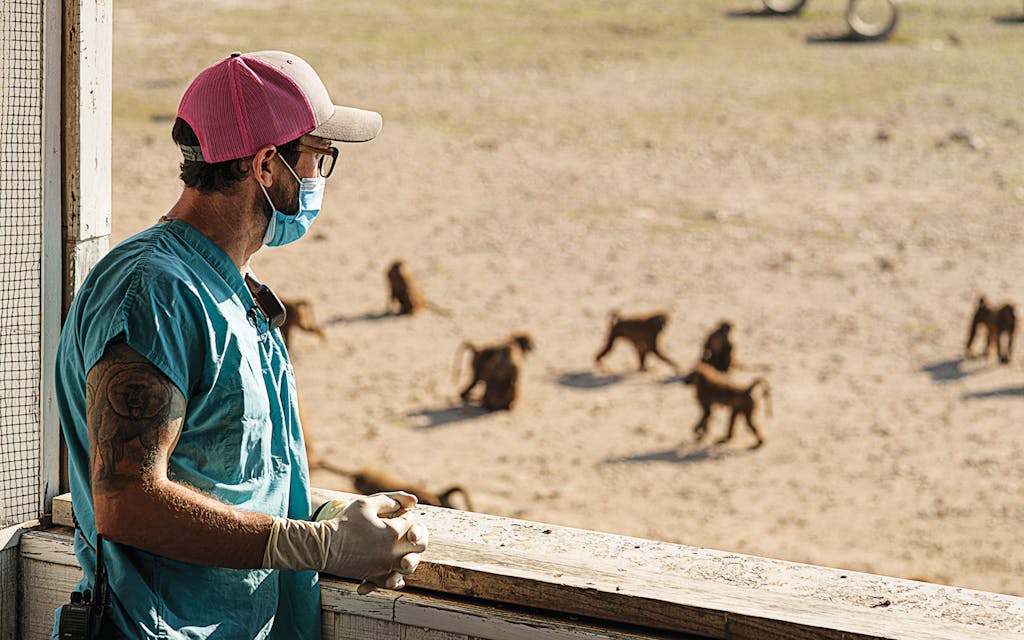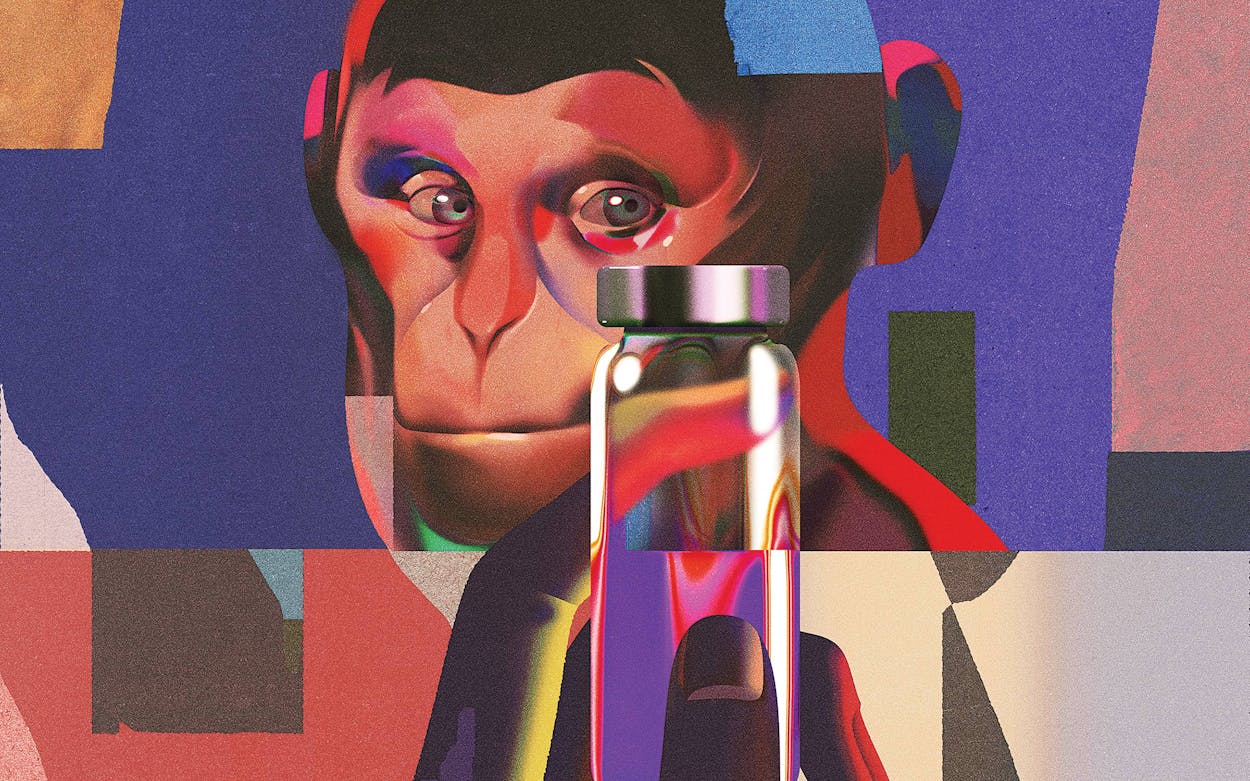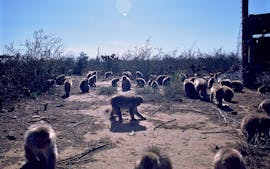Beyond a security checkpoint and down a two-lane blacktop road that curves along the edge of a two-hundred-acre campus on San Antonio’s West Side, scientists cultivate and study some of the most virulent pathogens in the world. As the pandemic’s frightening early days ticked by, in spring 2020, researchers in full-body protective suits, working in one of the facility’s six Biosafety Level 3 labs, carefully loaded a syringe-like device with SARS-CoV-2, the coronavirus that causes COVID-19. Then they deliberately infected a rhesus macaque by compressing the end of the device to atomize the virus—dispersing it into tiny airborne particles directed up the monkey’s nose.
Weighing about seventeen pounds, rhesus macaques are brown-gray primates with expressive pink faces and are native to much of southern Asia. Because of their genetic similarity to humans, they often act as our stand-ins in biomedical research. Hundreds of rhesus macaques live here at the Texas Biomedical Research Institute, one of a handful of federally designated national primate-research centers in the U.S. and the only one in the state.
The infected macaque was among the first creatures in the world to be immunized against COVID-19. Several weeks before arriving at Texas Biomed, it had been 1 of 6 injected with a Pfizer-BioNTech vaccine candidate, while another 6 received a slightly different formulation. Nine other macaques—the experiment’s control group—were injected with saline. The scientists in San Antonio were tasked with infecting all 21 of the monkeys with the coronavirus and tracking the results.
By July 2020 researchers had determined that Pfizer’s candidate vaccines were working—less viral RNA was found in the immunized macaques than in the control group. After human trials, the vaccine was approved under an emergency-use authorization in mid-December of that year, enabling millions of at-risk Americans to be protected against the deadly disease. A development process that would ordinarily have taken years had been completed in just nine months, thanks in part to what Texas Biomed calls its “animal heroes,” those macaques—all of whom were euthanized, as is standard for this sort of vaccine study.
Traditionally the institutions that conduct primate research haven’t sought to draw attention. The use of animal subjects has long attracted fierce opponents, who argue that the practice is unethical and the science derived from it unreliable. But having played a significant role in the rapid development of lifesaving COVID-19 treatments, Texas Biomed wouldn’t mind a little recognition.
The institute is raising funds to construct a $120 million Global Center for Bioscience that it hopes will function as a more welcoming “front door” for visitors to what has been a largely closed-off campus. The proposed building’s offices, labs, and meeting spaces are part of a planned roughly $300 million expansion that involves adding multiple facilities, vastly increasing the size of its research animal population, and doubling the institute’s personnel.
Yet these ambitions come as emerging technologies could spell an end to the need for biomedical research on nonhuman primates—raising new questions about the tricky ethics involved in saving human lives by sacrificing other creatures.

Thomas Slick Jr., an eccentric 26-year-old heir to an oil fortune, founded what became Texas Biomed on a working cattle ranch eight miles west of downtown San Antonio, in 1941. Much of its early work was devoted to livestock breeding, including the creation of a popular Brangus hybrid that combined the virtues of Brahman and Angus cattle. Slick later became a world traveler who led expeditions in search of the yeti in the Himalayas and Sasquatch in the Pacific Northwest.
In the fifties, the institute turned its attention to biomedical research and began importing baboons from Africa. By the eighties, it was testing early treatments for HIV and hepatitis C. In 1999 it established the Southwest National Primate Research Center, one of only seven such facilities in the country funded by the National Institutes of Health and the only one not associated with a university. Today it’s home to roughly five hundred marmosets, one thousand baboons (the world’s largest colony), and 1,500 macaques.
When the COVID-19 pandemic began, China, the United States’ top source for nonhuman primates, decided to begin keeping its supply to itself. This led to a bottleneck in animal-research projects elsewhere in the world. Cambodia, the next top supplier, partially filled the gap, but in November 2022 it, too, halted exports, out of concerns that it was contributing to the poaching of endangered wild macaques. Experts say the primate shortage has compromised critical biomedical research in the U.S., and Texas Biomed’s leaders have determined that the institute should help bolster the domestic supply.
Macaques are by far the primates in greatest demand—in part because their size makes them more manageable than larger primates, such as baboons. But each species has “really unique characteristics and unique targets for research,” says Corinna Ross, acting director of the Southwest National Primate Research Center. Baboons have been especially valuable for cardiovascular and neonatal research. Marmosets are frequently used in neuroscience and were test subjects for a Zika virus vaccine. Macaques have been used to study tuberculosis and HIV, as well as in COVID-19 research.
In a sleek second-floor conference room, Texas Biomed CEO Larry Schlesinger, who’s also a physician, explained that some experts predict infectious diseases will, by 2050, surpass heart disease and cancer as the world’s leading causes of death. “This is a big deal from a business perspective as well as a science perspective,” he says. It’s a challenge that he says the institute is uniquely equipped to confront because the other NIH-funded primate-research centers are affiliated with universities, where commercializing innovations isn’t the primary objective. Texas Biomed, by contrast, is focused on helping to bring biomedical products to market, and it has plentiful land on which to expand. The institute’s plans include the construction—already underway—of a $20 million complex for as many as six hundred more macaques, as well as a large veterinary clinic and pathology lab. Additional phases could allow the macaque colony to increase to about five thousand and the marmosets to about eight hundred.
Much as Houston’s MD Anderson is known as the premier cancer center in the U.S., Texas Biomed aspires to be the premier infectious disease institute. “In Texas we’re not known enough,” Schlesinger says. “I don’t think people appreciate just how much power we have in science.” In addition to its work on Pfizer’s COVID-19 vaccine, Texas Biomed was involved in developing Regeneron Pharmaceuticals’ monoclonal antibody therapy, as well as in major advances for hepatitis C patients that led to a 2020 Nobel Prize for some of its collaborators. Ebola therapies and vaccines tested in the institute’s Biosafety Level 4 lab have also shown promise. And last year the NIH selected the institute as a training center for tuberculosis researchers.
None of this would be possible without its nonhuman primates, Schlesinger insists. “Animals are a required commodity to improve human health,” he says. Yet a future in which research animals could be replaced with high-tech alternatives such as computer-modeling techniques and “organs on chips”—key chain–size microchips that can mimic how a given human organ will be affected by a drug—may arrive relatively soon. Proponents argue that these new options are more accurate than animal testing as well as more humane.
The Environmental Protection Agency has pledged to end its own testing on mammals by 2035, and late last year Congress abolished a 1938 rule that required that pharmaceutical products be tested on animals before being used in human trials. The measure “will avoid the needless suffering of countless animals, now that experimental drug testing can be done with modern non-animal alternatives that are more scientifically relevant,” said Senator Cory Booker, a New Jersey Democrat and the bill’s coauthor with Senator Rand Paul, a Kentucky Republican.
“We’re at the cutting edge of science that will enable us to replace monkeys someday,” Schlesinger agrees. “We want that more than anyone. Animals are very expensive, labor intensive, and require a lot of care.” But Schlesinger pushes back against those who say animal testing should be supplanted immediately by the new options. “The reality is it’s not ready for prime time,” he says of the emerging technology. “What are you going to do, just sit around and say, ‘I want an organ on a chip?’ The FDA is going to laugh. It’s not realistic.”
Though the Food and Drug Administration has signaled that it will accept alternatives to animal testing in some cases, a congressionally mandated report published this year by the National Academies of Science, Engineering, and Medicine found that none of the alternatives can fully replace nonhuman-primate testing—at least not yet.

Tucked away in a back corner of Texas Biomed’s campus, behind the six-acre, open-air baboon corral, sit three square buildings, each surrounded by four geometric domes known onsite as primadomes. These house the institute’s thirty “retired” chimpanzees, some of them more than fifty years old.
In 2013 the NIH reduced the number of chimpanzees used in research at the facilities that it funds to just fifty. “Their likeness to humans has made them uniquely valuable for certain types of research, but also demands greater justification for their use,” Dr. Francis Collins, then director of the NIH, said at the time. Two years later, the agency announced it would no longer support any biomedical research on chimps, and the U.S. Fish and Wildlife Service reclassified all chimps, including those in captivity, as endangered. Those policy changes effectively ended invasive biomedical research on chimpanzees in the U.S., including at Texas Biomed.
Some animal rights advocates would like to see this clemency extended to other species. Lisa Jones-Engel, a former primate researcher who now serves as a senior science adviser for the nonprofit People for the Ethical Treatment of Animals, cites some of the nation’s top medical scientists who recognize that data gathered from chimpanzee studies often don’t result in improved human health. If it doesn’t work with chimps, which along with bonobos are our nearest genetic relatives, sharing nearly 99 percent of our DNA, she says, “it’s not going to work with macaques, who we haven’t shared a common ancestor with for twenty-four million years, or marmosets, who we haven’t shared a common ancestor with for thirty-five or forty million years.”
It’s true that research conducted on animals doesn’t always translate into effective treatments for humans. For instance, a 2020 study at MD Anderson found that animal models were poor predictors of how cancer drugs would affect humans. “There is an urgent need to assess more novel approaches,” the researchers concluded. Indeed, roughly nine out of ten human drug trials fail because the drugs don’t work in humans, or their side effects are too severe. If the animal trials aren’t weeding out bad or ineffective drugs, animal rights advocates ask, why do we need them? Even so, some maladies, such as Ebola, are so severe that federal rules prohibit infecting humans with a pathogen to test a treatment—in cases such as this, the broad consensus in the medical community is that animal research can and does provide invaluable, lifesaving data.
The trustworthiness of Texas Biomed’s research was opened to criticism last year when Deepak Kaushal, then director of the Southwest National Primate Research Center, who was central to the Pfizer vaccine testing, admitted to falsifying data in work he’d completed at another institution. Texas Biomed replaced him as director, and his federally funded research was subjected to additional scrutiny by outside experts for one year, but he remains on its research faculty. Critics also point to the institute’s fourteen U.S. Department of Agriculture citations related to primates in its care, dating back to 2013—an average number among the seven national primate research centers, according to an analysis of USDA documents by Jones-Engel. Texas Biomed’s infractions ranged from peeling paint in animal enclosures to allowing an adult baboon to access another enclosure, where it killed an infant baboon.
Nevertheless, Texas Biomed firmly stands behind the work of its scientists. Ross, the primate center’s acting director, told me that critics don’t recognize that a deep love of animals is what first drew many, such as herself, to primate research. Lisa Cruz, the institute’s vice president for corporate communications, says that considering the thousands of nonhuman primates the institute cares for, “we have an extremely great track record of care and safety.” Numbers vary each year, but as of this summer, the institute is conducting tests on more than nine hundred monkeys. Some studies are “terminal,” meaning the primates will be euthanized—both to prevent the spread of a disease and to gather data from the autopsied bodies—but most involve monkeys that will be reused in future studies, kept for breeding, or retired. (A spokesperson for Texas Biomed declined to disclose what percentage of studies are terminal.)
According to Bob Fischer, an associate professor of philosophy at Texas State University and director of the Society for the Study of Ethics and Animals, “there’s a real tendency to demonize” in conversations about the use of animals in medical research. He notes that many consumers are complicit in the suffering of others—whether humans or nonhumans—more than they’d care to recognize. “If you go far enough back in the supply chain, for just about any product that you like, you will find horrors,” he says. Estimates for the number of animals used in biomedical research each year in the U.S. range from about 20 million to more than 100 million, but that’s a small fraction of those killed for food. And only about 0.5 percent of research animals are primates, according to a recent report from the National Academies.
John P. Gluck, a professor emeritus of psychology at the University of New Mexico, is another former primate researcher who came to regret his decades of conducting experiments on monkeys. He says he fears that norms within the scientific community overpower the basic instinct not to inflict pain on another intelligent living thing. “A good argument for doing the experiment is very meaningful,” Gluck says. “But the pain is still there, so does that pain still have a claim on us ethically? Does it still require something more from us? And I would say yes, it does.”
In this ethical debate, Gluck is focused primarily on animal welfare, while Texas Biomed’s Schlesinger is most concerned with improving human health. “I’m thinking about solving the world’s problems,” he says. “The goal is to use less animals, to use them in a more sophisticated fashion whenever possible, and to make sure that the studies are validated, so that the work done actually moves forward in the proper fashion. That’s what we can do. And that’s what I think Texas Biomed does really well.”
When weighing the risk of emerging global health crises against the accumulated suffering of research animals, judgments about the proper balance are inevitably subjective. Even before Pfizer reached out in early 2020 about testing its COVID-19 vaccine, Texas Biomed’s virologists, immunologists, and geneticists had already begun studying the novel coronavirus. Researchers infected dozens of primates—including baboons, macaques, and marmosets—with the pathogen to observe the course of the disease. These animals endured the little-understood effects of COVID to help determine which species would be best suited for testing the anticipated treatments to come. All the infected animals were eventually euthanized.
A Pfizer senior director would later say this swift action by the institute put the pharmaceutical giant a month ahead in getting its vaccine to the public. For each of the dozens of animals sacrificed, it could be argued, countless more human lives were saved. Infectious disease experts worldwide agree that there will be other pandemics, and Texas Biomed intends to help develop the next cures. For the foreseeable future, that work will hinge on the ethically charged issue of inflicting pain and death on humankind’s closest kin.
This article originally appeared in the September 2023 issue of Texas Monthly with the headline “The Monkeys Who Died to Fight COVID.” Subscribe today.
- More About:
- Health
- Animals
- San Antonio







